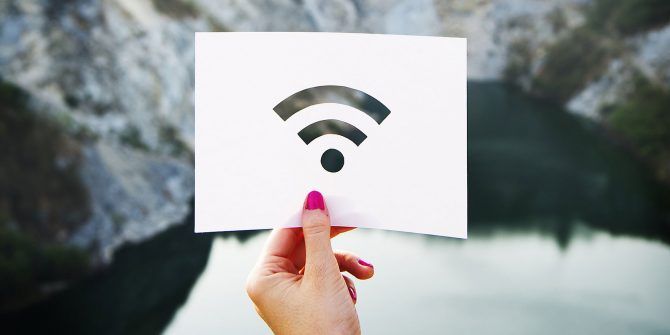Did you know that your Wi-Fi connection uses one of four different security types? While all of them are different, they’re not all equal; thus, it’s essential to learn what security type your Wi-Fi is using.
Let’s explore the four Wi-Fi security types and see which ones are the best to use.
What Are the 4 Wi-Fi Security Types?
Wi-Fi security comes in four different types. They’re not all equally secure, which is vital to remember when checking your own network’s protocol.
1. The Wired Equivalent Privacy (WEP) Protocol
WEP is the oldest of the security types, entering the computing world in 1997. Because of its age, it’s still prevalent in the modern era within older systems. Out of all the protocols, WEP is considered the least secure.
2. The Wi-Fi Protected Access (WPA) Protocol
WPA arrived as WEP’s successor due to the flaws that were found within WEP. It has additional features over its older brother, such as the Temporal Key Integrity Protocol (TKIP). This feature was a dynamic 128-bit key that was harder to break into than WEP’s static, unchanging key.
It also introduced the Message Integrity Check, which scanned for any altered packets sent by hackers.
3. The Wi-Fi Protected Access 2 (WPA2) Protocol
WPA2 is the successor to WPA and brings more features into the mix. It replaced TKIP with the Counter Mode Cipher Block Chaining Message Authentication Code Protocol (CCMP), which did a better job with encrypting data.
WPA2 was very successful and has maintained its position as the top protocol since 2004. On March 13, 2006, the Wi-Fi Alliance stated that all future devices with the Wi-Fi trademark had to use WPA2.
4. The Wi-Fi Protected Access 3 (WPA3) Protocol
WPA3 is the new kid on the block, and you can find it in routers produced in 2019. With this new format, WPA3 brings better encryption on public networks to prevent hackers from harvesting information from them.
It’s also easier to connect to a WPA3 router with a device with no display, and it has some additional features to protect against brute force attacks.
It’s likely to be the new WPA standard in the future, so it’s a good idea to find out everything you need to know about WPA3.
Why the Wi-Fi Security Types Matter
Knowing your Wi-Fi security protocol is essential for your network’s security. Older protocols are more vulnerable than newer ones and are far likelier to suffer a hacking attempt. There are two reasons why older versions are weaker than newer ones:
- The older protocols were designed in an earlier time before it was fully understood how hackers attacked routers. The more modern protocols have fixed these exploits, while the older versions still have them lurking within their code.
- The longer a protocol has been around, the more time hackers have to crack the security. Due to WEP being around for a very long time, hackers have found many exploits within it, making it an insecure protocol in the modern era.
What Security Type Is My Wi-Fi?
Now you understand why checking the type is essential and what you should be using, and why older protocols aren’t as good. So, let’s explore how you check your connection type to ensure you’re using the best.
How to Find Your Wi-Fi Security Type in Windows 10
On Windows 10, find the Wi-Fi Connection icon in the taskbar. Click it, then click Properties underneath your current Wi-Fi connection. Scroll down, and look for the Wi-Fi details under Properties. Under that, look for Security Type, which displays your Wi-Fi protocol.
How to Find Your Wi-Fi Security Type in macOS
Checking the Wi-Fi security type on macOS is very easy. Hold down the Option key and click on the Wi-Fi icon in the toolbar. It will show your network details, including what security type you’re on.
How to Find Your Wi-Fi Security Type in Android
To check on an Android phone, go into Settings, then open the Wi-Fi category. Select the router you’re connected to and view its details. It will state what security type your connection is. Note that the path to this screen may differ depending on your device.
How to Find Your Wi-Fi Security Type on an iPhone
Unfortunately, there’s no way within iOS to check your Wi-Fi security. If you want to check your Wi-Fi’s security strength, your best bet is to either use a computer or log into the router through the phone.
What to Do Next With Your Wi-Fi Security
Once you’ve found your Wi-Fi security type, how do you use that information to decide what to do next? Let’s break down your ideal plan of action for each protocol.
What to Do If Your Security Type Is WPA3
If your connection is using WPA3, congratulations. You’re using the best Wi-Fi protocols, and as a result, you don’t need to upgrade. You’re also very likely to be using modern hardware so that an upgrade can wait for at least a few more years.
What to Do If Your Security Type Is WPA2
WPA2 is also a secure protocol, so you don’t need to worry about updating your hardware. However, if you’re interested in staying up-to-date, it’s worth looking at the current generation of routers with WPA3 compatibility. If you liked the sound of the features we listed under the WPA3 protocol, you should consider upgrading to a router that supports it.
What to Do If Your Security Type Is WEP Or WPA
If your network is either WEP or WPA (without any numbers after it), then you’re at risk of a cyber-attack. As a result, you’ll want to upgrade to a WPA2 or WPA3-compatible router to secure yourself.
It’s also worth checking if your router has been set to use a lesser security type. Read the manual for your current router and check if you can toggle the security type. If you can’t, it’s worth investing in a new router.
Thankfully, even the cheaper models available today support WPA2 due to the Wi-Fi Alliance dictating that they have to. Furthermore, you can ensure a quality product by looking out for the best brands when buying a wireless router.
The Difference Between “Personal” and “Enterprise” WPA
If your protocol is WPA, you may have noticed that it was labeled either “Personal” or “Enterprise.” “Personal” is for home use, and “Enterprise” has some additional security features to make it suitable for sensitive business use. Personal level is fine for everyday use, so don’t worry if your home router doesn’t use Enterprise-level security.
Keeping Your Wi-Fi Network Safe
If you’re worried about hackers getting into your network, it’s a good idea to use the best security protocol you can. WPA3 and WPA2 users should not worry, while WPA and WEP users should consider upgrading.
Keeping your Wi-Fi network safe can be daunting. Thankfully, you can make it a little less stressful by performing some simple ways to secure your router.
About The Author

